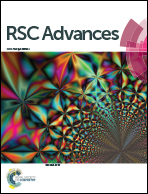Surface modified PMMA nanoparticles with tunable drug release and cellular uptake†
Abstract
In this manuscript, we report the microemulsion mediated synthesis of fluorophore-doped PMMA nanoparticles, with different sizes and surface coatings, for potential biomedical applications. Size variation was achieved by modulating the amount of co-surfactant n-butanol. After synthesis, their size, surface, and optical properties were evaluated. Nanoencapsulation was found to enhance the stability of the fluorophore against chemically induced quenching. The surface of the nanoparticles was modulated via coating with hydrophilic polymers PAA and PVA. Hydrophilic coating resulted in enhancement of the colloidal stability of these nanoparticles in physiological saline medium. The release pattern of the encapsulated fluorophore was found to depend on both the size and surface properties of the nanoparticles. Fluorescence bioimaging and fluorescence analysis of lysates of treated cells were used to study the cellular uptake of the nanoparticles. The cellular uptake was also found to depend on both size and surface properties of these nanoparticles. Finally, cell viability (MTT) assay in vitro has indicated the absence of cytotoxic effects of these doped nanoparticles. These results underscore the promise of these nanoparticles in non-toxic biomedical applications.


 Please wait while we load your content...
Please wait while we load your content...